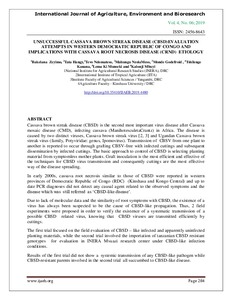| dc.contributor.author | Bakelana, Z. |
| dc.contributor.author | Tata-Hangy, W. |
| dc.contributor.author | Tevo, N. |
| dc.contributor.author | Mahungu, N. |
| dc.contributor.author | Monde, G. |
| dc.contributor.author | Kanana, T. |
| dc.contributor.author | Lema, K.M. |
| dc.contributor.author | Kalonji, M. |
| dc.date.accessioned | 2020-02-27T09:48:22Z |
| dc.date.available | 2020-02-27T09:48:22Z |
| dc.date.issued | 2019-01-01 |
| dc.identifier.citation | Bakelana, Z., Tata-Hangy, W., Tevo, N., Mahungu, N., Monde, G., Kanana, T., ... & Kalonji, M. (2019). Unsuccessful Cassava Brown Streak Disease (CBSD) evaluation attempts in western Democratic Republic of Congo and implications with cassava root necrosis disease (CRND) etiology. International Journal of Agriculture, Environment and Bioresearch. 4(6), 284-297. |
| dc.identifier.issn | 2456-8643 |
| dc.identifier.uri | https://hdl.handle.net/20.500.12478/6795 |
| dc.description.abstract | Cassava brown streak disease (CBSD) is the second most important virus disease after Cassava mosaic disease (CMD), infecting cassava (ManihotesculetaCrantz) in Africa. The disease is caused by two distinct viruses, Cassava brown streak virus [2, 3] and Ugandan Cassava brown streak virus (family, Potyviridae: genus, Ipomovirus). Transmission of CBSV from one plant to another is reported to occur through grafting CBSV-free with infected cuttings and subsequent dissemination by infected cuttings. The basic approach to control of CBSD is selecting planting material from symptomless mother plants. Graft inoculation is the most efficient and effective of the techniques for CBSD virus transmission and consequently cuttings are the most effective way of the disease spreading.
In early 2000s, cassava root necrosis similar to those of CBSD were reported in western provinces of Democratic Republic of Congo (RDC) (Kinshasa and Kongo Central) and up to date PCR diagnoses did not detect any causal agent related to the observed symptoms and the disease which was still referred as ‘CBSD-like disease’.
Due to lack of molecular data and the similarity of root symptoms with CBSD, the existence of a virus has always been suspected to be the cause of CBSD-like propagation. Thus, 2 field experiments were proposed in order to verify the existence of a systematic transmission of a possible CBSD related virus, knowing that CBSD viruses are transmitted efficiently by cuttings.
The first trial focused on the field evaluation of CBSD – like infected and apparently uninfected planting materials, while the second trial involved the importation of tanzanian CBSD resistant genotypes for evaluation in INERA Mvuazi research center under CBSD-like infection conditions.
Results of the first trial did not show a systemic transmission of any CBSD-like pathogen while CBSD-resistant parents involved in the second trial all succumbed to CBSD-like disease. |
| dc.description.sponsorship | International Institute of Tropical Agriculture |
| dc.description.sponsorship | Democratic Republic of Congo |
| dc.format.extent | 295-297 |
| dc.language.iso | en |
| dc.subject | CASSAVA |
| dc.subject | VIRUSES |
| dc.subject | ROOTS |
| dc.subject | NECROSIS |
| dc.subject | TRANSMISSIONS |
| dc.title | Unsuccessful Cassava Brown Streak Disease (CBSD) evaluation attempts in western Democratic Republic of Congo and implications with cassava root necrosis disease (CRND) etiology |
| dc.type | Journal Article |
| cg.contributor.crp | Agriculture for Nutrition and Health |
| cg.contributor.crp | Roots, Tubers and Bananas |
| cg.contributor.affiliation | National Institute for Agricultural Research Studies, DR. Congo |
| cg.contributor.affiliation | International Institute of Tropical Agriculture |
| cg.contributor.affiliation | Institute Faculty of Agricultural Sciences, Yangambi |
| cg.contributor.affiliation | Kinshasa University |
| cg.coverage.region | Africa |
| cg.coverage.region | Central Africa |
| cg.coverage.region | East Africa |
| cg.coverage.country | Democratic Republic of the Congo |
| cg.coverage.country | Tanzania |
| cg.coverage.hub | Central Africa Hub |
| cg.creator.identifier | Nzola Mahungu: 0000-0002-3781-0838 |
| cg.researchtheme | Biotech and Plant Breeding |
| cg.identifier.bibtexciteid | BAKELANA:2019 |
| cg.authorship.types | CGIAR and developing country institute |
| cg.iitasubject | Agronomy |
| cg.iitasubject | Cassava |
| cg.iitasubject | Plant Breeding |
| cg.iitasubject | Plant Diseases |
| cg.journal | International Journal of Agriculture, Environment and Bioresearch |
| cg.notes | Open Access Article |
| cg.accessibilitystatus | Open Access |
| cg.reviewstatus | Peer Review |
| cg.usagerightslicense | Creative Commons Attribution-ShareAlike 3.0 (CC BY-SA 3.0) |
| cg.targetaudience | Scientists |
| cg.identifier.doi | https://dx.doi.org/10.35410/IJAEB.2019.4480 |

